For far too long, the construction industry has overlooked its responsibility to prioritize environmental impact. As of 2020, buildings accounted for 37% of worldwide energy consumption and CO2 emissions related to energy use. Given the rapid pace of urbanization, this figure could double in the years to come unless we embrace new approaches to real estate development. In light of global mandates, corporate social responsibility, conscious consumerism, and the potential risks facing future generations, the need for green buildings has never been more pressing.
Green buildings are designed to minimize carbon footprints not only during the construction phase, but also after the building is occupied. The design prioritizes features that reduce dependency on energy and water consumption, thereby enabling users to reduce their impact on the environment. In addition, materials used in green buildings are responsibly and locally sourced, with most of the waste being recycled within the establishment. Several internationally recognized certification bodies help validate green building structures, providing credibility to the initiatives undertaken by organizations, standardizing global efforts, and enhancing the saleability of real estate.
Having said that, the construction industry has certainly faced challenges in adopting green building practices due to various obstacles. Early adopters encountered difficulties in balancing the costs of traditional building practices versus those of eco-friendly ones.
However, as corporate mandates and consumer mindsets have evolved, the industry is beginning to see the benefits of going green. Nowadays, commercial buildings with green building certifications can command rental yields that are 5-7% higher than those of non-certified structures. Large corporations are willing to pay these premiums as they align with their global CO2 mandates and help offset their carbon footprints. The residential sector is also following suit, with buyers seeking homes that promote environmental sustainability and leave a smaller carbon footprint.
Designing green buildings can be challenging. While significant decisions such as building orientation, facade shading and material selection impact the customer experience, they also serve as key components of achieving efficiency in green building practises. In our city -centre asset, we have successfully integrated these two requirements by incorporating aluminium band facade elements to provide greater shading coefficients and reduce the overall heat gain, while replacing the erstwhile concrete chajja designs. This design modification helped to lower our building’s carbon footprint from both, an executional as well as an operational standpoint.
In conclusion, the incorporation of green building practices in real estate development, especially in Bangalore can bring about numerous benefits for both realtors and homeowners. These benefits include increased efficiency, improved air quality, and reduced environmental impact. Although there may be some challenges involved in implementing these practices, the long-term advantages make it a worthwhile investment for a sustainable future.


